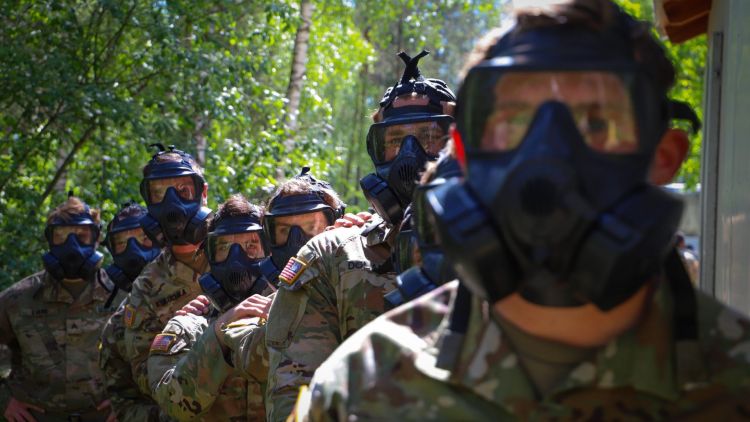In today’s world, warfare is constantly evolving, and so are the dangers that our soldiers face on the battlefield. It’s no longer just bullets, bombs, and other lethal projectiles that troops have to worry about—chemical warfare is a real and growing threat.
That’s where Battelle’s latest project comes into play.
The US Department of Defense (DOD) recently awarded the company a $53-million contract to develop the Reactivating Nerve Agent Treatment System (RNATS), a groundbreaking solution that could literally be a lifesaver for soldiers exposed to nerve agents.
But this development isn’t just about a fancy new piece of technology—it’s about changing the way we think about modern warfare, focusing on how medical countermeasures can make all the difference in soldier survivability.
Here’s what we know so far about this latest nerve agent countermeasure.
The Evolution of Chemical Warfare and Soldier Survivability
Let’s face it: chemical warfare is a terrifying reality.
From World War I to more recent conflicts, the use of nerve agents has been one of the most devastating and unpredictable threats on the battlefield.
These agents attack the body’s nervous system, shutting down basic functions and leading to severe injury or death.
In today’s world, warfare is constantly evolving, and so are the dangers that our soldiers face on the battlefield. It’s no longer just bullets, bombs, and other lethal projectiles that troops have to worry about—chemical warfare is a real and growing threat.
That’s where Battelle’s latest project comes into play.
The US Department of Defense (DOD) recently awarded the company a $53-million contract to develop the Reactivating Nerve Agent Treatment System (RNATS), a groundbreaking solution that could literally be a lifesaver for soldiers exposed to nerve agents.
But this development isn’t just about a fancy new piece of technology—it’s about changing the way we think about modern warfare, focusing on how medical countermeasures can make all the difference in soldier survivability.
Here’s what we know so far about this latest nerve agent countermeasure.
The Evolution of Chemical Warfare and Soldier Survivability
Let’s face it: chemical warfare is a terrifying reality.
From World War I to more recent conflicts, the use of nerve agents has been one of the most devastating and unpredictable threats on the battlefield.
These agents attack the body’s nervous system, shutting down basic functions and leading to severe injury or death.
As these threats have evolved, so has the need for better ways to protect soldiers.
That’s where RNATS comes in—a new system that’s designed to give our boys on the ground a fighting chance if they’re exposed to nerve agents by reactivating a key enzyme in the body, acetylcholinesterase (AChE), which is responsible for transmitting signals between neurons.
When a nerve agent attacks, it blocks this enzyme, and the body’s communication system essentially shuts down.
RNATS aims to reverse this process, giving soldiers the treatment they need to survive and recover.
British troops blinded by poison tear gas during the Battle of Estaires, World War I, April 1918. (IWM/Wikimedia Commons)
RNATS: A Game Changer in Chemical Warfare Defense
The RNATS technology works by using reactivators that target the AChE enzyme.
In simpler terms, it’s like flipping a switch that gets the body’s nervous system back on track after a nerve agent attack. This is a major leap forward from the current standard treatments, which are effective but not nearly as fast or reliable as what RNATS promises to deliver.
The reactivators in RNATS will be sealed in vials and ready to use whenever and wherever they’re needed.
This is not just another medical advancement—it could be a game-changer in how militaries around the world handle chemical warfare.
By directly addressing the effects of nerve agents, RNATS offers a faster, more effective solution that can save lives and improve the chances of soldiers surviving in extreme combat situations.
Pharmaceutical Advancements in Military Preparedness
While we usually think of tanks, planes, and high-tech weapons when it comes to military preparedness, there’s a growing role for pharmaceutical innovations in defense.
Battelle’s partnership with CMC Pharmaceuticals to develop RNATS shows just how crucial drug development is becoming in military strategy.
It’s crucial to ensure that RNATS is ready for action, with proper production, testing, and approval processes in place—not just about creating the medicine.
“Battelle has a long history of working with the DOD on protecting military troops from chemical threats,” explained Drew Cawthon, the company’s Business Line Director, in a September 9 press release.
Pharmaceutical advancements like RNATS are becoming just as vital to defense strategy as traditional weapons systems.
After all, in modern warfare, a soldier’s ability to survive and recover from a chemical attack is just as important as their ability to fight back.
Global Implications: Collaborative Defense Measures for International Allies
One of the most exciting aspects of the RNATS project is that it’s not just for US troops.
Once developed and approved by the Food and Drug Administration (FDA), RNATS will be made available to US allies as well.
This highlights the growing need for international cooperation when it comes to facing global threats like chemical warfare.
A Medical Airmen using toxic chemical agent (nerve agents GB and VX) during a emergency response training, 2010. (DVIDS)
No country can go it alone, and developing shared defense resources like RNATS strengthens alliances and ensures that multiple nations are better prepared for whatever comes their way.
In a world where chemical warfare is an ever-present threat, collaborative defense measures are crucial.
By making RNATS available to international allies, the US is reinforcing the importance of working together to face modern warfare’s most dangerous challenges.
Long-Term Impact on CBRN Warfare Preparedness
The Pentagon first discussed the RNATS strategy at a medical countermeasures convention in late 2023, where the focus was on improving soldiers’ protection against Chemical, Biological, Radiological, and Nuclear (CBRN) warfare.
RNATS isn’t just a short-term fix—it’s part of a long-term plan to better prepare soldiers for modern threats. The technology being developed now could lay the groundwork for even more advancements in the future.
As warfare continues to evolve, so too must the tools we use to protect those on the front lines.
RNATS is just one part of a broader strategy to ensure that soldiers are not only equipped to fight but also to survive and recover from the threats they face, whether those threats are visible or invisible.
Concluding Thoughts: Medical Countermeasures as the Future of Defense
At the end of the day, the development of RNATS represents a critical shift in how we approach military defense.
It’s no longer enough to simply arm soldiers with weapons—we also need to arm them with the medical tools they need to survive.
Battelle’s work on RNATS is a testament to the growing importance of pharmaceutical innovation in modern warfare. It’s about giving soldiers a fighting chance against one of the most terrifying weapons in the modern arsenal: nerve agents.
This is not just about saving lives; it’s about changing the way we think about military readiness and defense strategy.
As RNATS moves closer to becoming a reality, it’s clear that medical countermeasures like this will play an increasingly vital role in protecting soldiers and shaping the future of global defense.
—
Disclaimer: SOFREP utilizes AI for image generation and article research. Occasionally, it’s like handing a chimpanzee the keys to your liquor cabinet. It’s not always perfect and if a mistake is made, we own up to it full stop. In a world where information comes at us in tidal waves, it is an important tool that helps us sift through the brass for live rounds.



